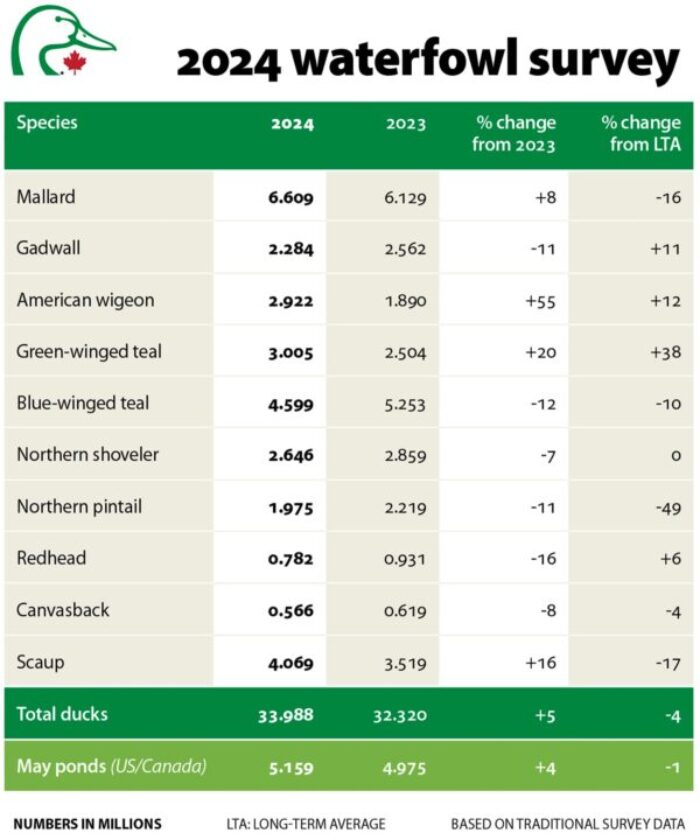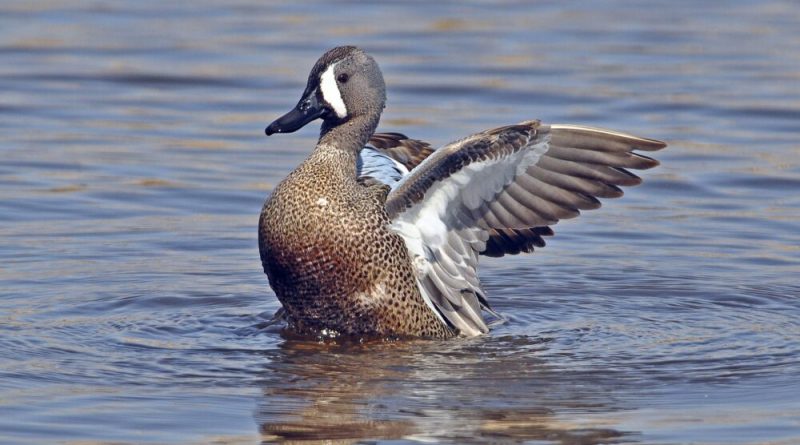Canada’s duck populations show first increase since 2015
Special to WC Online
WEST CARLETON – For the first time since 2015, Canada’s duck population is on the rise, estimated at 34 million, according to recently released statistics from Ducks Unlimited Canada (DUC).
“From droughts to floods to fires, Canada has once again experienced a surge of extreme weather throughout 2024 that’s impacted waterfowl habitats,” the DUC released in a statement Aug. 21. “This has left many hunters and birders wondering about the status of populations of their favourite species and whether they’ll see an abundance of birds in the sky during fall migration.”
According to the 2024 Waterfowl Breeding Population and Habitat Survey (WBPHS; often referred to as BPOP) released Wednesday, there’s some good news on the horizon: “we’ll be seeing more birds over our binoculars, blinds and backyards during this year’s fall flight.”
That’s because the results mark the first increase in total surveyed breeding ducks since 2015.
“The annual Waterfowl Breeding Population and Habitat Survey offers the best insight and, according to the 2024 report, we can expect to see a slight increase,” the DUC said.
Total populations were estimated at 34 million breeding ducks in the traditional survey area, five per cent higher than 2023’s estimate of 32.3 million and four per cent below the long-term average (since 1955).
“These results are an important reminder that continued investments in habitat conservation and restoration are needed at a continental scale to support waterfowl across their annual cycle, but particularly during the breeding period,” DUC waterfowl research scientist Matt Dyson said. “As an organization that’s been studying the drivers of waterfowl population dynamics for more than 85 years, Ducks Unlimited Canada remains vigilant in our efforts to work with our many partners on the landscape and take conservation action.”

While all habitat is important to the life cycles of waterfowl, science shows that breeding areas have the greatest effect on waterfowl populations. These areas are found mostly in Canada and the northern United States, in landscapes such as the Prairie Pothole Region and the boreal forest.
The continued decline of blue-winged teal was noted by waterfowl scientists like Dyson, who says “the decline can likely be closely tied to the ongoing drought situation across their core breeding area in the Prairies.”
“It was nice to see mallard populations tick up after a few years of declines, as well as substantial jump in American wigeon numbers,” Dyson said. “These increases are likely tied to boosts in boreal forest breeding populations of these species and particularly in Alaska where they saw bumps in 2024.”
Regarding the waterfowl and habitat conditions data from the eastern survey regions, Dyson says: “With the exception of mallard, all primary species surveyed in the Eastern Survey Area increased since 2023. Notably, American black duck are up 17 per cent and 23 per cent above the long-term average. It is encouraging to see continued population stability, and growth, for this species following years of declines. Conditions in the Eastern Survey Area (ESA) are generally good, which should bode well for continued positive trends for ducks in this region.”
The Waterfowl Breeding Population and Habitat Survey was started in 1955 and is the largest and longest running wildlife survey in the world. Its results have guided waterfowl harvest and habitat management continentally by shedding light on the large-scale dynamics of migratory species.
The survey, also referred to as the Breeding Population Survey (BPOP) or the May Survey, is run jointly by the United States Fish and Wildlife Service (USFWS) and Environment and Climate Change Canada’s Canadian Wildlife Service (CWS) with support provided by other groups like DUC. From mid- to late May, the USFWS teams up with the CWS as well as state and provincial agencies to conduct the survey. Using airplanes, helicopters and keen-eyed ground crews, the organizations examine breeding habitat and populations over more than 3.6 million square kilometres of Canada and the northern United States. DUC biologists are part of the crews that count ducks from the ground, which provide important verification and corrections for counts done by air.













